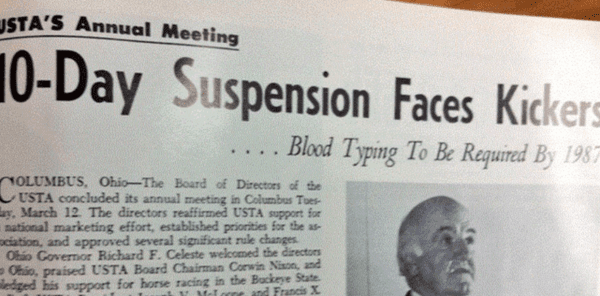This sport’s dire need for relevancy
The ‘Agri-Business’ Derby, calf-roping and farm fresh milk trifecta are all still relevant. Why, and why not us?
by Dean Towers
I received an email from a harness racing pal this week: “The last seal hunt is over. The animal rights activists have won. The European Union has banned the sale of seal products so the market was constrained in any case. But here’s the kicker: in 2015 the Norwegian government stopped subsidizing the seal hunting industry. Up to 80 per cent of a sealer’s income came from the subsidy. Sound familiar?”
I looked into this a little more and my friend’s information was correct. The seal hunt in Norway is done. Why this has happened is an interesting question.
“Seal hunting is an old culture and tradition. It’s been a big part of northern Norwegian culture. (But) people buy meat in the store that’s packed in plastic, and they don’t want to see how animals are killed,” said a Norwegian hunter.
We could go through a litany of characteristics about seal hunting, but in a nutshell: seal hunting was stopped because it lacked relevancy in today’s world. Things that are relevant to the public, economy and politicians do not get banned.
Over in racing, just this week in Pennsylvania, alarm bells we’ve often heard were sounded once again.
“Even with a quarter of a billion (dollars) in subsidies each year, the racing industry has still seen a decline in attendance, wagers and the number of breeders. If lawmakers opted to redirect the $250 million to pressing priorities, it would have saved a lot of pain for many small business owners who lost their jobs and for low-income people who now have to pay higher taxes.”
Harness racing is an easy target for lawmakers, just like the seal hunt was for activists. This sport is simply not very relevant in today’s society.
If the pertinence of any industry is important in the changing world, how does harness racing become more relevant? Can it? I think it’s an important question and I’ll offer a few strategies that I think could help the cause.
First we must look to our equine counterparts, the thoroughbred racing industry, for guidance. It’s no coincidence that when a sport is trial ballooned to be “banned” (or to have their funding eliminated or greatly reduced) there generally is a hierarchy – dogs, harness and the runners. Thoroughbreds are highest on the totem pole.
Thoroughbreds have remained relevant, certainly in part, through their events. Here are the Google searches for the Kentucky Derby versus various sporting events for 2016.
Sure, that’s the Derby you might say, but it goes beyond that. Let’s ask Pennsylvania lawmakers what they might want to target first for a funding reduction – the sport which has attracted Kentucky Derby champions California Chrome and Nyquist to Parx, or the sport that races a whole whack of races with meagre attendance?
I don’t want it to seem like I’m picking on Pocono or The Meadows. This is bigger than holding a few stakes races and inviting politicians; it needs to be industry led.
For example, where is the harness racing Triple Crown? I think it’s somewhere in the attic, under the Niatross-over-the-hub rail issue of Hoof Beats. Despite someone in the industry talking about reviving it (seemingly) each year, it just goes back into the dusty attic until someone else brings it up again. It’s the harness racing version of the summer solstice.
Harness racing will never possess anything as relevant as a Kentucky Derby; that’s obvious, and it’s just the way it is. But creating big events to be used as public relation vehicles and building a following for the sport — so those who hold the purse strings can see and touch it — should be a goal.
Second, let’s move away from pure horse racing and head to the friendly confines of Alberta for the Calgary Stampede.
Despite being plagued in animal activist hell (or if you prefer, “a spectacle of animal abuse”), this anachronistic, agrarian event somehow keeps rolling, with over one million in attendance each year along with full government support. How do they do it?
The Stampede has remained relevant because they’ve been cognizant to the writing on the wall and doing enough – while working with governments – to ensure its event is protected. In response to horse deaths in chuckwagon racing, they changed the rules on a dime, making the event much safer for athletes and more palatable to the public. In 2015 (for the first time ever), they immediately banned a cowboy who used the whip too aggressively in an event. Adding to the public relations power of the ban, the cowboy was the reigning world champion, not some also-ran.
With the Stampede there’s no equivocation. There’s no waffling. These things were just done.
Meanwhile in harness racing, to say it’s not like this is putting it mildly.
If someone is charged with horse abuse in this sport, there’s a good chance you’ll see him or her back training in six months. This angers everyone, but it’s a truism. If a school bus driver gets charged with drunk driving, the parents and school board will ensure he never drives anyone’s kids to school again. If you abuse a horse, the USTA and the grassroots in the sport need to follow that lead.
In addition, eliminating a practice that has poor optics to politicians and the general public – like, for example, kicking – seems to be as difficult as landing someone on the moon. Scratch that. As this screenshot shows from way back in 1986, it’s more difficult. The moon landing only took nine years to achieve.
The easiest way to stay irrelevant is to be paralyzed by dysfunction.
Last up in our quest for relevancy we’ll fly into the world of milk. Yes, milk.
In 1984, American consumers drank about 26 gallons of milk, per capita, per year. In the same year, milk producers spent $27 million on advertising through their slush fund.
More than two decades later, the industry had spent about $1 billion cumulatively on advertising, and consumption dropped to just over 20 gallons per capita, per year.
That sounds like some pretty terrible marketing spend, doesn’t it? No, not really, because milk producers weren’t only talking to consumers with their public relations and marketing campaigns, they were speaking to those who held all the money – politicians. That worked exactly as planned. Since the mid-1990’s, subsidies for the milk industry are over $5.6B, and they’re not going anywhere.
It’s pretty difficult to say no to Doogie Howser. And it’s a heck of a lot easier to hold onto government support when you stay relevant.
Harness racing – and again, this is no secret – has a relevancy problem. But, with foresight and planning (and probably a little slice of the billions in slot revenue) there are things that can be done. Thoroughbred racing, the Calgary Stampede and dairy farming are all present day examples of old time agrarian businesses and events that have remained relevant. Harness racing can learn from them, if we’re willing to listen.
















